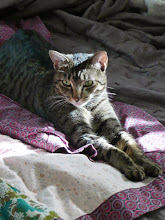Hans Trausil, a translator and poet of the 1920's, gives us this glimpse of a tough little urban scrapper.
The Cat (Italian Quarter, New York City)
In front of the shop
Where the copper light of dried fish glitters
On the door-post like a sun-ray,You see the tail of the hungering one
Brushing the grey pavement.Softly like a wind-blown rag of yellow furIt curls behind the wheel of the wagonWhere she sits feigning a life most tedious;
As though longing for the oblivion of slumberShe huddles crookedly between her lean flanksAnd blinks at you slantingly and yawns,And at times a twitching
Ripples through her hollow bodyWherein dwells the murderess and harlot;As though for pastime she crouches there silently
A shabby Buddha, solitarily enthroned.
-- Anthology of Magazine Verse. W.S. Braithwaite, ed. New York: Schulte Pub. Co. [etc.], 1922. p. 12. Originally in The Measure, March 1922. (Public Domain)







